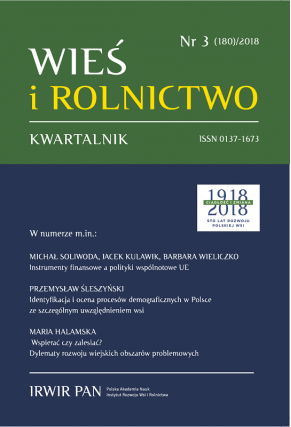Operational Subsidies and Financial Stability of Farms in the European Union
DOI:
https://doi.org/10.53098/wir032018/05Keywords:
subsidies, agricultural income, financial surplus, financial stabilityAbstract
The purpose of the article was to identify financial situation if farms operating in the European Union Member States, account taken of operating subsidies, as well as factors that influenced the financial surplus (cash flow in operating activities). The ability to earn a positive financial surplus was recognized as a manifestation of a farm’s financial stability. The data was sourced from FADN database and the research period covered the years 2009–2015. The quartile method was used for grouping Member States; economic size of a farm was the variable used for the classification of a farm to a relevant quartile. Econometric models have been used for panel models with fixed effects. The research showed that farms operating in the European Union differed in terms of production factors, especially land and capital, which was reflected in the achieved economic and financial results. Direct subsidies have been an important element of income over the years in almost all the Member States. Without subsidies, almost half of the EU farmers would not be able to generate any income from farming. The models constructed indicated that the amount of financial surplus was influenced by various factors depending on the economic size of a farm. Regardless of the quartile, the direct subsidies were the inhibitor of financial surplus.References
Buks J., Pietrzykowski R. (2015). Relacje między dochodem rolniczym a dopłatami unijnymi w Polsce. Roczniki Naukowe Stowarzyszenie Ekonomistów Rolnictwa i Agrobiznesu, 18 (3), 67–71.
Ciaian P., Swinnen J.F.M. (2009). Credit market imperfections and the distribution of policy rents. American Journal of Agricultural Economics, 91 (4), 124–139. DOI: https://doi.org/10.1111/j.1467-8276.2009.01311.x
Crockett A. (1997). Why is financial stability a goal of public policy? Economic Review, 4, 5–22.
Czubak W., Sadowski A., Poczta W. (2011). Wpływ reformy systemu dopłat bezpośrednich na dochody polskich gospodarstw rolnych z pola obserwacji FADN. W: J. Kulawik (red.). Dopłaty bezpośrednie i dotacje budżetowe a finanse oraz funkcjonowanie gospodarstw i przedsiębiorstw rolniczych (s. 60–79). Program Wieloletni 2011–2014, Raport nr 20. Warszawa: Instytut Ekonomiki Rolnej i Gospodarki Żywnościowej – PIB.
Fidrmuc J., Schardax F. (1999). Increasing integration of applicant countries into international financial markets: Implications for monetary and financial stability. Focus on Transition, 2, 18–46.
Gorczyńska M. (2013). Stabilność finansowa a zrównoważony rozwój przedsiębiorstwa. Zarządzanie i Finanse, 2 (2), 99–110. zif.wzr.pl/pim/2013_2_2_8.pdf [dostęp: 27.07.2017].
Grzelak A. (2012). Sytuacja ekonomiczna w rolnictwie na tle tendencji ogólnogospodarczych w Polsce w latach 1995–2010. Roczniki Naukowe Stowarzyszenia Ekonomistów Rolnictwa i Agrobiznesu, 14 (3), 104–109.
Hennessy D.A. (1998). The production effects of agricultural income support polices under uncertainty. American Journal of Agricultural Economics, 80 (1), 46–57. DOI: https://doi.org/10.2307/3180267
Jabłoński A. (2015). Stabilność finansowa przedsiębiorstwa a jego model biznesu. Zeszyty Naukowe Uniwersytetu Przyrodniczo-Humanistycznego w Siedlcach, Seria: Administracja i Zarządzanie, 104, 87–96.
Jóźwiak W., Mirkowska Z. (2008). Polskie gospodarstwa rolne w pierwszych latach członkostwa. Zagadnienia Ekonomiki Rolnej, 2, 19–32. https://depot.ceon.pl/bitstream/handle/123456789/…/Józwiak%20Mirkowska.pdf [dostęp: 25.09.2017].
Korol J., Szczuciński P. (2012). Ekonometryczne modelowanie zróżnicowania związków w sektorze małych i średnich przedsiębiorstw w przestrzeni regionalnej. Zeszyty Naukowe Uniwersytetu Szczecińskiego, Studia i Prace Wydziału Nauk Ekonomicznych i Zarządzania (Metody Ilościowe w Ekonomii), 26, 209–224.
Latruffe L., Bravo Ureta B., Moreira V.H., Desjeux Y., Dupraz P. (2011). Productivity and subsidies in European Union countries: An analysis for dairy farms using input distance frontiers. Paper prepared for presentation at the EAAE 2011 Congress, August 30 to September 2, 2011, ETH Zürich, Zürich, Switzerland. http://purl.umn.edu/114396 [dostęp: 24.07.2017].
Marks-Bielska R., Babuchowska K. (2009). Wsparcie dochodów rolników w formie dopłat bezpośrednich. Zeszyty Naukowe SGGW w Warszawie. Ekonomika i Organizacja Gospodarki Żywnościowej, 75, 135–148. DOI: https://doi.org/10.22630/EIOGZ.2009.75.34
Mary S. (2012). Assessing the impacts of pillar 1 and 2 subsidies on TFP in French crop farms. Journal of Agricultural Economics, 64 (1), 133–144. http://onlinelibrary.wiley.com/doi/10.1111/j.1477-9552.2012.00365.x/full [dostęp: 24.07.2017]. DOI: https://doi.org/10.1111/j.1477-9552.2012.00365.x
Mrówczyńska-Kamińska A. (2008). Znaczenie rolnictwa w gospodarce narodowej w Polsce, analiza makroekonomiczna i regionalna. Zeszyty Naukowe SGGW w Warszawie. Problemy Rolnictwa Światowego, 5 (20), 96–107. DOI: https://doi.org/10.22630/PRS.2008.5.69
Poczta W. (2008). Rolnictwo. W: I. Nurzyńska, J. Wilkin (red.). Polska wieś 2008: Raport o stanie wsi (s. 27–45). Warszawa: FDPA.
Poczta W., Śledzińska J., Mrówczyńska-Kamińska A. (2009). Determinanty dochodów gospodarstw rolnych Unii Europejskiej według typów rolniczych. Warszawa: Szkoła Główna Gospodarstwa Wiejskiego. DOI: https://doi.org/10.22630/EIOGZ.2009.76.44
Rizov M., Pokrivcak J., Ciaian P. (2013). CAP subsidies and the productivity of EU farms: Factor markets. Working Paper No. 37, March 2013. https://ssrn.com/abstract=2275273 [dostęp: 24.07.2017].
Ryś-Jurek R. (2009). The output, incomes and assets-capital relations in the individual farms. Journal of Agribusiness and Rural Development, 1 (11), 177–188.
Slavkovský P. (2005). Społeczne i kulturowe konteksty rozwoju rolnictwa słowackiego w XX wieku. Infrastruktura i Ekologia Terenów Wiejskich, 1, 121–131.
Smędzik-Ambroży K. (2015). Wpływ dopłat bezpośrednich na zrównoważenie gospodarstw rolnych w Polsce – próba symulacji na przykładzie gospodarstw FADN z regionu Wielkopolska i Śląsk. Progress in Economic Sciences, 2, 107–117.
Soliwoda M. (2016). The impact of the support instruments of the Common Agricultural Policy on economic and financial stability of farms in EU countries. Acta Universitatis Lodziensis, Folia Oeconomica, 2 (319), 99–116. DOI: https://doi.org/10.18778/0208-6018.319.07
Wąs A. (2004). Znaczenie dopłat bezpośrednich i płatności ONW w kształtowaniu wyników finansowych w warunkach różnych scenariuszy rynkowych i wariantów organizacji gospodarstw rolniczych. Roczniki Nauk Rolniczych, Seria G, 91 (2), 16–27.
Zawojska A. (1997). Zróżnicowanie dochodów w gospodarstwach rolniczych w wybranych krajach Unii Europejskiej: Streszczenie rozprawy doktorskiej. Zagadnienia Ekonomiki Rolnej, 2–3, 110–113.
Zhu X., Lansink A.O. (2010). Impact of CAP subsidies on technical efficiency of crop farms in Germany, the Netherlands and Sweden. Journal of Agricultural Economics, 61 (3), 545–564. DOI: https://doi.org/10.1111/j.1477-9552.2010.00254.x
Zygierewicz M. (2013). Stabilność finansowa. Annales Universitatis Mariae Curie-Skłodowska. Sectio H, Oeconomia, 47 (3), 685–695.
Downloads
Article file downloads
Pages
How to Cite
Issue
Section
License
Copyright (c) 2018 Wieś i Rolnictwo

This work is licensed under a Creative Commons Attribution 4.0 International License.










